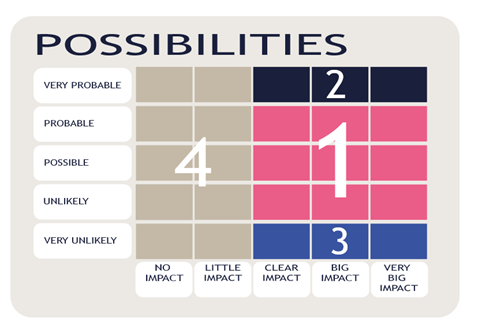Can the future be predicted?
The goal of companies is to succeed and generate profit. They aim for a competitive advantage over their competitors. A strategy, or plan, is created to achieve the desired goal. Competitive advantage is gained by being the first to offer products or services that meet customer demands. But how can we know what customers will want a few years from now? Can the future be predicted?
Unpredictable VUCA World
The future cannot be predicted – or you can try, but rarely get it right. Predicting has always been difficult. Its challenge is especially emphasized now, as changes in the world happen faster, there is a lot of uncertainty, and various political decisions continuously shake the world. You can no longer rely on things progressing according to familiar patterns. The world surrounding us at the moment is described by the term VUCA, which stands for Volatile, Uncertain, Complex, and Ambiguous.
Signs and Signals of the Future
The future cannot be predicted, but signs of it can be observed, and new emerging phenomena can be studied. These signs are called weak signals, and already identified phenomena are called trends. Weak signals can be seen as indications of possible changes that might become significant in the future. A weak signal could be something that still seems strange, attracting attention or even resistance. When encountering such a thing, one can consider whether it is related to an ongoing phenomenon. Trends are changes that forerunners are already adopting. Various organisations also compile lists of identified trends. For example, lists of megatrends can be found published by SITRA or the EU’s collaborative body, ESPAS.
Classification, and Selection
Nowadays, there are good tools available for analyzing signals and trends, which help to concretize their impact. For example, the Futures Wheel is a method where the direct effects and consequences of something are considered. By visualizing in this way, concrete challenges and opportunities related to one’s own organization can be mapped out on the circles.

When identifying future signs, it’s not advisable to react to all of them. First, you should somehow identify which are the key cards on which to build your strategy. It’s difficult to gain a competitive advantage by investing only in completely certain future changes, as competitors are likely to invest in them as well. An edge can be gained from potential changes that may become significant, even if their realization is not yet fully certain. To assist with classification, you can use a risk matrix from risk management by highlighting the opportunities that are slightly less likely to occur – there you can find the differentiating factors.

Prepare for the Future
The future is not an independent fate beyond our control; we can always influence and prepare for our own future. The future starts right now. By conducting research and analysis related to future forecasting, we can gather material to create possible future scenarios. Based on the understanding gained, we can brainstorm solutions and update strategies to meet upcoming challenges. By acting in this way, you are likely to stay a step ahead of competitors and remain robust and resilient against future challenges.
More information?
Are you interested in preparing for the future? Read more about how Huld Future Puzzle can help you prepare for the future and get in touch if you want to spar more on the topic.
